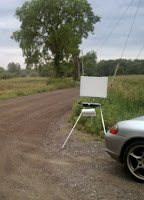When There Just Isn't Time...
Seems to me that there are an awful lot of days when there just isn't time to go painting en plein air. At least there are an awful lot of reasons for staying in the studio, leaving all the schlepping for another day.
Wednesday seems to have become our obligatory plein air day. But this week Todd is swamped with commitments he must fulfill before heading off to the Vermont Workshop next week. So, for me, there isn't the peer pressure there might have been.
Still, since Todd couldn't come, I invited some students to join me at Appleton Farms----me to paint, they to draw. It seemed a good mix of some painting time for me and some casual drawing instruction for them.
But, of course, real life intervened. One student had a gallery errand that must be run, another had a mid-day doctor's appointment, etc. Also rain was forecast.
I , too, had things I needed to do, and so I had more than enough excuses I could make to myself about why I couldn't possibly go do an outdoor grisaille.
Unfortunately, when it was time to head off to the studio this morning, it wasn't actually raining. It's true there was a lowering sky, but no drops. Hmmm.... what now for my excuse?
So, trying to be a real grown-up, I headed off to Appleton Farms, in Ipswich. But I'd only gone part of the distance when I noticed a road I'd seen a hundred times. This time it was clearly saying "Paint Me!" So I screeched to a halt, and set up. I knew that I only had Liquin, ultramarine blue, and burnt umber in my kit. But these are my standard ingredients for making a grisaille (a useful term, even though neither of my colors is gris, or blanc or noir either).
At this point, I've set up my new easel, thankfully with an improved version of paper towel stowage since the debacle of a few weeks ago.
This road is little-travelled, so I didn't need to worry about being in anyone's way.
The only canvas I had with me was 18"x 24", and so I was really in for it. No wee, tiny vignettes-----no mini-excuses for a painting.
As it turns out, I spent 45 minutes on the grisaille, rushing along because of fear of iminent rain (which never came).
I mostly wanted to get some of the larger masses indicated, so that, if I had to stop, I'd have something to show for my time.
Although I hardly had a plein air masterpiece completed, I did have a sense of a painting that I might work on another time.
Later in the day, after my chores, I arrived at the studio. Now I had a chance to flesh out some of the masses, and to add a bit of transparent color. I also used a bit of opaque paint to change some of the drawing in the grisaille.
Now I had another 40 minutes invested in the painting. It definitely has issues that need to be resolved, and it largely still needs to be "painted".
But maybe next February, when New England is locked in winter snow and ice, I'll pull out this bit of a May day, and amid all the whiteness of the season I'll find a cheering suggestion of Spring.
None of us ever has enough time. And we all have a million excuses. But it seems to me that this morning's 45 minutes, and this afternoon's 40, were well spent. Because I certainly didn't have the time, or maybe the weather, for "making a painting" today, I might easily have skipped the whole exercise.
But now, because I convinced myself to make what the time and weather would allow, I have stored up possible treasure for future days.
Go forth and do likewise! Catch some fish for future frying.
















